#Don’t come at me if this is anatomically inaccurate I probably should have used reference but it’s more fun this way lol
Explore tagged Tumblr posts
Text

Perfect excuse to draw some wings <3
Hermitober day 16: feather!
#cat does art#Don’t come at me if this is anatomically inaccurate I probably should have used reference but it’s more fun this way lol#Grian#Hermitober#Very fun
10 notes
·
View notes
Text
Kyidyl Explains Bones - Part 6
(All of these are under the KyidylBones tag.)
Age Determination
Well, age at death anyway. I’m gonna put this warning up front:
Today’s post will contain pictures of the skeletons of children. This is something that a lot of people, even those who think they won’t be bothered, find upsetting. This goes double if you actually have children. This post will also include frank discussion of child death.
You have been warned.
So what is age determination? Age determination isn’t the process of figuring out how old a set of remains is, it’s the process of figuring out how old the individual was when they died. Because of the sensitive nature of the topic, I’m putting everything behind a cut today.
Ethics: Beyond the normal respectful approach, there aren’t separate ethical considerations with dealing with age like there are for sex and race. Just be considerate of the fact that child death is super upsetting to some people. I literally had people in my classes at the masters level who were moved to tears by some of the younger remains, so even when you’re used to looking at things from a clinical perspective, kids can be tough.
General: Age is separated into three general categories: juvenile (0-early 20s), adult, and elderly. Juveniles are from birth until the last known skeletal change takes place. IE, until all your teeth come in and all your bones fuse. These are really good indicators of age, so we use them as much as we can for as long into the lifespan as we can. Adults range from “done growing” to “showing signs of degeneration” EG, arthritis and that kind of thing. Elderly is anything older than that.
Also, this applies to all age categories: size is not an indicator of age. Ever.
Juveniles: We say juveniles instead of children because people in their late teens and early 20s aren’t really children, but they haven’t finished growing yet. So juvenile is a more inclusive term, and the more accurate one. That said, kids are by FAR the easiest to know the age of. Juvenile remains do not look like small adult remains, because juveniles that have skeletons that do not resemble adult skeletons beyond the basic “ah, that’s probably a human”.
There are a few ways that we determine the age of a juvenile, and the first thing we check is the teeth. Before the body, before any other signs. Because the teeth are consistently accurate across race, sex, economic standing, any pathologies, etc. Teeth are formed and come in on a schedule. Here is that schedule:

And here is a link to a high res PDF version that you absolutely should take a look at (Source).
Beyond this, the 3rd molar AKA wisdom teeth come in between ages 17-25. Now, archaeological remains won’t have scars on the bone from the wisdom teeth removal that a lot of people commonly undergo, but in the future that will be visible on the bone. I’ll get into this more when I get around to doing the damage and pathology posts, but healed bone has a different appearance than unbroken bone, so a healed-over tooth socket has a different appearance than bone that never had a tooth there to begin with. In addition, while tooth eruption in a living juvenile is accepted as the time when the tooth breaks through the gums, in the remains of a juvenile we can see un-erupted teeth within the jaw. It looks like this:
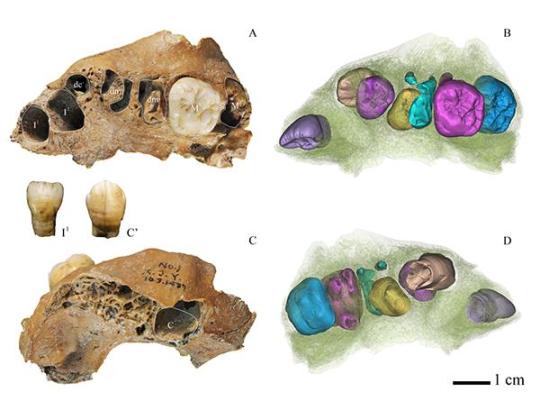
(Source)
As an aside: those lines on the teeth are called enamel hypoplasia, and I’ll cover it more in the teeth post, but essentially if you don’t get proper nutrition as a child when your adult teeth are developing in your jaw you get these lines in them.
So anyway, because teeth come in on such a precise schedule, and because teeth survive better than anything else in your body (especially in a child’s body. Childrens’ bones are fragile, partially ossified, and they decay quickly.), they’re very good for estimating age at death. Even more so than bones, because bones can be altered by illness, malnutrition, repetitive activity, or genetic anomalies. Teeth almost never are. Or, rather, their rate of growth isn’t.
Another thing we look for when determining age at death is the fusion of the bones. See, as you’re growing you have more bones. Those get larger until they meet up with the bone they’re part of, and then they start to fuse. These are called epiphysis (growth plates). Very young children don’t even have entirely ossified (bone instead of cartilage) bones, let along epiphysis that touch. Babies don’t show up often in the archaeological record because of this. To better illustrate this, here is an image of an xray of a baby’s hand:

(Source)
You’ll notice that the finger bones (Metacarpals and carpels, known collectively as phalanges.) have small little bones at the ends that aren’t attached - that’s not an anomaly, that’s normal. Those are the physis, which will fuse later in life after they are larger, and the plate between them from which they grow is the epiphysis. You can also see that the wrist bones have barely begun to ossify and don’t show up on the xray, and the physis for the radius and ulna (arm bones) also haven’t begin to ossify and thus don’t show up - that’s why the arm bones look like one bone. They aren’t, they have an epiphysis at either end (Your elbow is a separate bone called the olecranon and it doesn’t fuse until later on.). This happens at a very predictable rate, and so we can tell how old someone is from a combination of their teeth and which bones have and have not ossified and fused. In addition, the bone of the epiphysis has a unique texture that is referred to as “billowy” in the literature (even tho I hate that word). Here’s a picture:
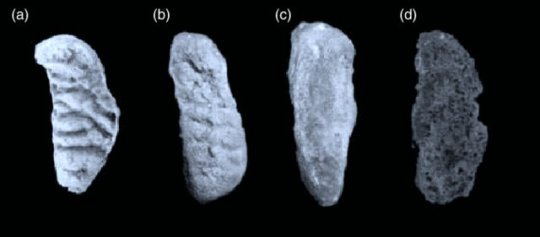
(Source)
The one on the left is what you want to look at, since this is a progression through age. Also I sniped this from a paper on age estimation, so if you’re interested in this take a look at it. It’s on researchgate so it’s not behind a paywall. As an aside: researchgate is amazing and you should all learn to use it.
Anyway, see that bumpy texture on the left? That’s what unfused bone looks like at the growth plate. This actually applies to, as far as I know, all land mammals. So if you find animal bones with this texture at the end of the bone, then that animal was a juvenile when it died. Bones fuse at different times in your life, but we know the times when they fuse. There are 206 bones in the adult body, so that would be a lot for me to try and put in a tumblr post, but if you google a specific bone you should be able to find the ages they fuse. I believe, if memory serves, that the skull sutures are the last to fully fuse, and they in fact continue to become more tightly fused as your life goes on. I’ll cover that in the next section tho. It will hold together as a teenager, but the skull bones take a long time to fuse to each other. Two of the last epiphysis to fuse though are the iliac crest (The curved part of the hip - it’s actually its own separate bone. Like just the small, smooth curved part.) and the sternal end of the clavicle (clavicle = collarbone, and the sternal end is the medial part towards the sternum.). This happens in your early to mid 20s.
So teeth and bone fusion are the two most used methods of age estimation. So if anyone ever shows you a small skeleton with fused bones and calls it a child, roll your eyes at them. It’s not a child.
One last note on juvenile skeletons: until the individual undergoes puberty, sex and race determinations are extremely difficult (teeth can be used for race, but not for sex. Not really, anyway.). So again, anyone who professes to know the sex of a set of pre-pubescent remains without like...a gravestone or something telling them is probably a liar. Right now the methods for doing that are either expensive (genetics) or inaccurate. And doing genetic evaluations on old juvenile remains is difficult, because their bones are more fragile than adult bones and break down easier, which exposes the DNA to easy degradation. It’s not impossible, it’s just usually more difficult and more expensive.
For reference, here is a juvenile skeleton laid out in standard anatomical position. There is more than one individual here, so ignore any of the bones outside the arms and above the head.

(Source)
Adults and the Elderly: After an individual finishes growing, estimating their age becomes increasingly difficult. There’s no such thing as, for example, an average number of tooth cavities. In addition, the natural growth and destruction of your bone cells over your lifetime means that things you do habitually can significantly alter the shape of your bones and the rate at which they break down.
However, there are a few things that can be used. Joints wear down at a fairly consistent rate, and arthritis leaves specific markers on the bones that we can identify as arthritis rather than normal wear and tear. This is most easily views in two places: the public symphasis (the front where your two hip bones meet.) and the acetabulum (The socket that the round end of your thigh bone is in.). The picture I used above is an image of the wear and tear seen on a series of pubic symphysises (symphysii? IDK.). And so these are matched against skeletons whose age at death was known and age ranges for changes to this area were arrived at.
When I was doing my MSc, we did a project where we were assigned a set of remains and had to use everything we’d learned in the course to do a full evaluation of our skeletons. Well, the majority of my skull was missing and so I used the acetabulum to do age estimation on the skeleton (I had some teeth, but not most of the ones that are diagnostic of age, which I’ll cover in a sec.). This is an image from and a link to one of the papers I used:

(Source)
Two things happen here as you age. One, the edges of the socket become damaged and it starts to change the anatomy (F is oldest). Two, that space in the middle is called the acetabular fossa, or the acetabular notch. And as you can see, the shape of it changes over time due to normal wear and tear. In combination with resources like the one I linked, we can use this to estimate the age of an adult or elderly individual.
Another tool we use has to do with the fusion of your growth plates. After the bones fuse, the line is still visible. Throughout your life the remodeling (normal breakdown/growth of bones and healing from damage.) causes the sutures to be come less and less visible. We call this obliteration. In the elderly, most of their sutures and growth plates will be completely obliterated. For example, the femur is in four pieces as a child. The main body of the femur, the head of the femur, the greater trochanter (The big bump on the top outside. This is like...the part that’s wides below your hips where your thigh meets your pelvis, but on the outside.), and the condyles (the rounded pieces on the far end.). The greater trochanter fuses and obliterates pretty early on, but the head and the condyles are pretty easy to see even in adults. Here’s an example showing the femoral head:
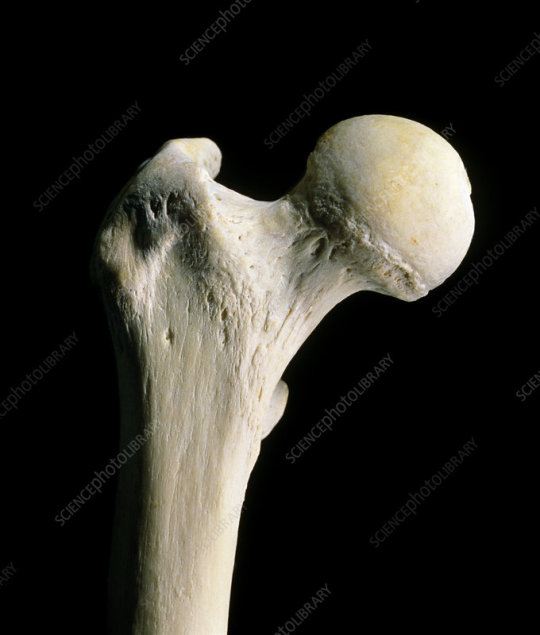
(Source)
As you can see, the trochanter has fused and is obliterated, but the head has fused and you can still see the line from the growth plate. The sutures in the skull are especially good for this, as cranial sutures take the majority of the lifespan to obliterate (sometimes they never fully do.). If you see a smooth skull, that person was ooooold.
The last easily accessible way we assess age at death is via tooth wear. Now, this won’t work in modern skeletons, which is why there’s a lot of research surrounding the evaluation of age at death. We’re well aware that after humans entered roughly the industrial age, our foods became soft and teeth no longer wear like they should, and after that point in time it’s not possible to use the standardized methods of tooth wear to evaluate age. Well, I should rephrase, it won’t be possible in westernized and industrialized societies. Cultures in Africa and South America that still practice pastoral or hunter/gatherer lifestyles will likely still have expected tooth wear. Anyone who lives in a society that has and uses grocery stores or doesn’t use two rocks to mill flour (Do not underestimate how much bread people ate.), is not going to have expected tooth wear (so it’s not about rural vs city.).
See, it’s normal and natural for teeth to wear. It’s normal and natural for the yellowish substance below the enamel, called dentin, to show. Dentin is almost as hard as enamel, and it actually regrows. We evolved to have tooth wear both on the surfaces and between the teeth. Humans used to eat much tougher foods, and even when we weren’t, our foods had a lot of grit in them (IE, tiny pieces of stone from milling flour. I have a whole ass theory about the role of dirt in the evolution of teeth for all animals but that’s neither here nor there.) and wore our teeth down. Wear isn’t a sign of bad dental hygiene, it’s a sign of a tougher diet. After the industrial age we started using different methods to produce food and started eating softer food overall, so we stopped putting the stresses on our jaws required for both proper tooth wear and the proper growth of our teeth (AKA: wisdom tooth impaction.). So normally worn teeth look like this:

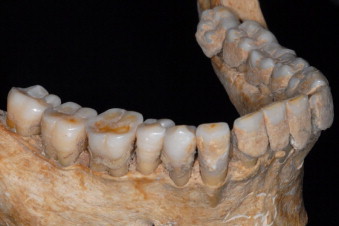
(Source for both images)
If you’ll notice in that top image the lines where the teeth meet fit exactly together. This is because of tooth wear. Interestingly you’ll also notice in the bottom image that this individual’s teeth are unevenly worn, meaning they chewed on the right side of their mouth. This is actually something we see all the time because of both handedness, and insult to the teeth on one side of the aw (AKA it was painful cause they had cavities.). This individual was likely a young adult given that they don’t have a lot of tooth wear to begin with, but they were preferentially using one side of their mouth to chew and so it is more worn than it would be for someone who wasn’t doing that. Here is the chart we use to grade tooth wear and age on adult teeth:
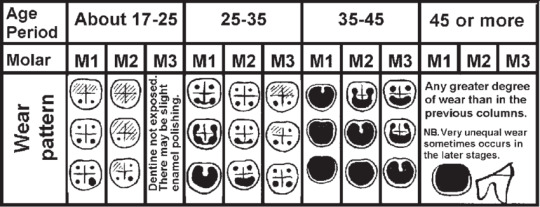
(Source)
That link has a larger version of the chart and more images.
So the fact that I’m 40 and still can feel all the cusps on all of my molars is an anomaly compared to previous humans. Soft foods. So if you compare the above image of the jaw with the chart, you’ll see that the individuals in both pictures have wear in the 25-35yrs old age rage, or what we would consider to be a young adult. And before you start talking about average age of humans back in the day, don’t forget that the average includes a lot of dead children. Once you made it to adulthood you lived a decent amount of time.
So those of you who are older than your 30s or so might not remember this, but when your adult incisors come in they had small ridges on the edges. It was easier to tell on your top teeth (maxillary incisors) than your bottom ones (mandibular incisors.), but it’s present on both. These bad boys:

(Source)
That is obviously a living human, but I’m showing you because they wear quickly. They do, however, wear at a prescribed pace so if a set of remains has them they were young. Sometimes they’re gone before you’re even an adult, but I figured I’d mention them because they are another kind of tooth wear.
Disease: The last thing that helps in age determination are age-based diseases. Namely, osteoarthritis and osteoporosis. There are circumstances wherein someone younger can have both of those pathologies, but that’s why we have all of the other things. So if we see signs of arthritis in a younger person, we’ll have the other signs to help us realize that they aren’t an elderly individual.
Osteoarthritis is, essentially, a thinning of the cartilage, fluid, and other soft tissues in the joints, causing the bones to rub against each other instead of sliding nicely on the cartilage. Now, a certain amount of thinning is expected with age - obviously, as arthritis in the elderly is extremely common even now. But osteoarthritis is an escalation of the normal wear and tear into a pathology. Osteoarthritis damages the joints, and so bone attempts to regrow, so you see a lot of abnormal outgrowths of bone that fit tightly together because they were rubbing against each other. You also see, in extreme cases, striations on the bones where they were grinding together. Like this:

(Source)
This is a knee joint, viewed from the posterior side. You can see on the bottom condyle and the opposing articular surface that there are lines. Those lines are from the bones grinding. You also can see, especially on the tibia, all those little funky looking bone bits. All that roughness sticking out around end, below the flat surface. Some roughness there is normal, but that’s rougher than it should be and that’s the result of osteoarthritis.
The other disease common in the elderly is osteoporosis. Osteoporosis is an illness that causes compact/cortical (the thicker hard bone around the spingy bone to thin and become porous (hence the name.). I’ve held bone with extremely advanced osteoporosis and they are about half the weight of normal bones. So that’s the first sign. The next sign is that they’ll be damaged, both from the natural processes of time and from subsequent handling, because they’re farm more fragile than health adult bone. The vertebra also take on a “squished” appearance due to the forces of gravity and the remodeling during the life of the individual. You also will often see poorly healed breaks (I’ll show you more of this later in this series when I get to pathologies.).
So that brings us to the end of the bit about age determination. Hope you guys are enjoying this series. :) I think next up is gonna be teeth! =D
#science#KyidylBones#archaeology#forensic#forensic anthropology#skeleton#age#human skeleton#human remains#educational#infodump#bones#human bones
55 notes
·
View notes
Text
Akoya and Yumichika: Just the beauty aesthetics? [Comparison]
Note: This is merely based on the observations of me, a nerd who has not watched the whole of Bleach and got most of what I know from the smatterings of episodes and chapters I’ve seen (as well as summarized stuff from elsewhere).Thus, I may or may not be wrong/inaccurate on the Yumichika front--or the Akoya one, for that matter, given I haven’t really watched Boueibu in a while, either.
With that in mind, let’s delve in!
On the surface level, Akoya and Yumichika already seem plenty similar--they both adhere strongly to their conceptions of beauty (which are remarkably similar, tbh), are generally disdainful/condescending of most others (especially those that don’t follow said conception of beauty) under a relatively polite veneer, tend to have one of their motifs being some sort of flowers, etc etc. In short, it really does seem like they’re birds of the same feather (no pun intended regarding Yumichika’s peacock motif). They even both use “boku” as the pronoun to refer to themselves I ca n ‘t
However, is that really all there is to them that’s similar?
One could argue that, yes, they’re only superficially similar. But for me, the answer to that question is--more or less--”no.” Delving deeper reveals a fair amount of hidden depths that actually parallel each other very well.
For starters, the few people Akoya and Yumichika have let into their hearts are people they’re fiercely loyal to--for Akoya, that’s Kinshirou and Ibushi, while for Yumichika, that’s Ikkaku (a longtime friend, if manga and expanded anime flashbacks are any indication) and more or less his division Captain. Those are the people they would go to great lengths to please and care for; this is easily shown when Akoya was implied to be furious on Kinshirou’s behalf in episode 12 of season 1 upon finding out that they were tricked (as well as his frequently amiable interactions with Ibushi, such as when they discussed feng shui in episode 10 of the same season), or...well, when Yumichika leapt to avenge Ikkaku after the latter was cut down by zombie!Toshiro during the last arc of Bleach.
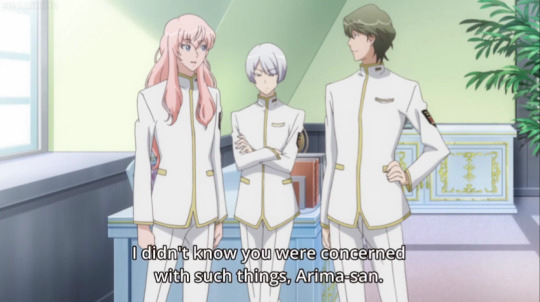
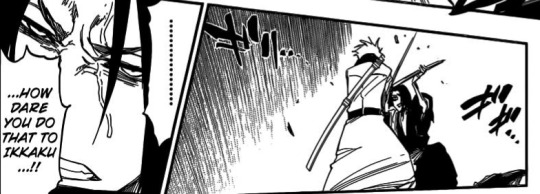
Although admittedly, Yumichika did sacrifice a fair bit more initially due to his loyalty (read: hiding his zanpakuto’s true powers to avoid ridicule by the people he’s loyal to), the two of them still are similar in their loyalties in how they clearly appreciate the people they’re loyal to--and to some extent, this loyalty is reciprocated. Kinshirou and Ibushi both treat Akoya on equal terms and clearly come to appreciate his presence, while Ikkaku similarly entrusts Yumichika with some of his greatest secrets and leaps to the latter’s defense when he was clearly in great danger.
Moving on--it also should be noted that both Akoya and Yumichika are notably very observant and cerebral to some extent. In Akoya’s case, he best shows this side of him in season 1, episode 6, where he very nearly singlehandedly destroyed the existence of the Defense Club by some rather clever manipulations and tactics (ostensibly based on a reasonable-sounding “rule” and playing on Io’s desires; this bit is honestly best said by elucida here), but what’s perhaps less talked about is how, in episode 11 of season 2, he’s implied to have deliberately taunted Ryuu to get him back on his feet, knowing that the tone he used would have had that effect--which more or less indicates his strong intuition and ability to read people’s personalities:
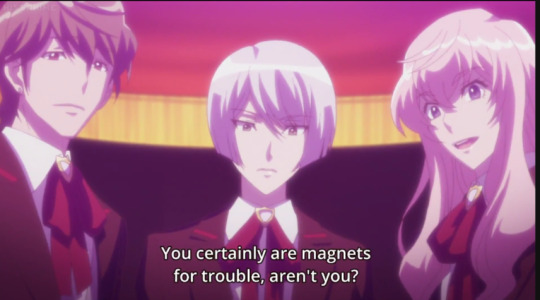
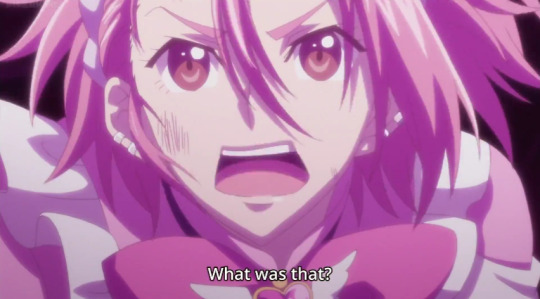
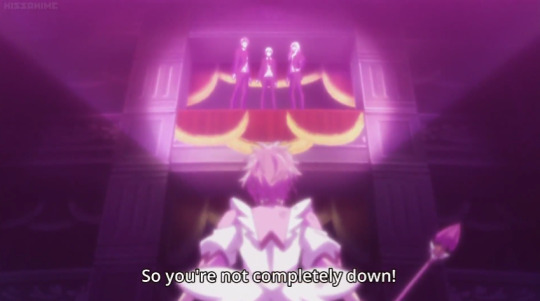
Basically, he’s a manipulative and clever little shit who knows how to use his observations to his advantage--or to his sassing. Either way, it’s effective--and also very much like Yumichika, especially in the cleverness and sass.
On the Bleach side, given what kind of series it is, Yumichika doesn’t get those same moments very often. However, that’s not to say he doesn’t have his moments, as this moment indicates:
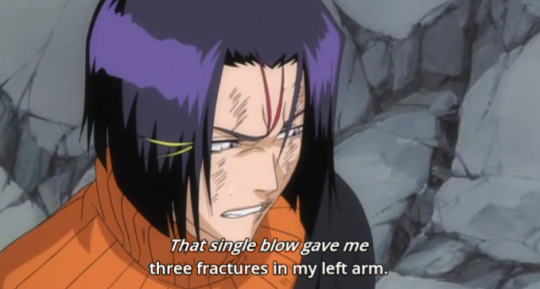
He literally got slammed into the pillar he was guarding and almost immediately knew that he’d broken his arm in three places due to his opponent’s attack. Which is a pretty big feat, keeping in mind that he’s not a part of the Medical Division, was likely dazed from the impact, and in general should not have been in the best place to make that sort of exact observation. This shows some fairly impressive observation skills (and likely anatomical knowledge), let’s be real.
And of course, the final arc shows this aspect of him a bit more--one instance that comes to mind from memory is that he’s able to conclude from Giselle’s taunting alone that she was purposely making them attack, further indicating that he also has surprisingly strong intuition.
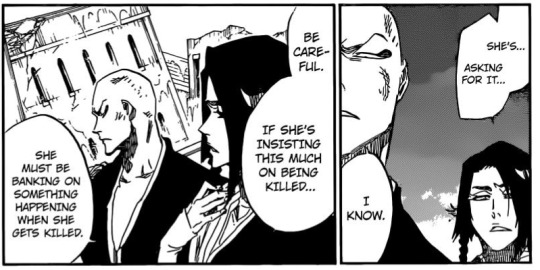
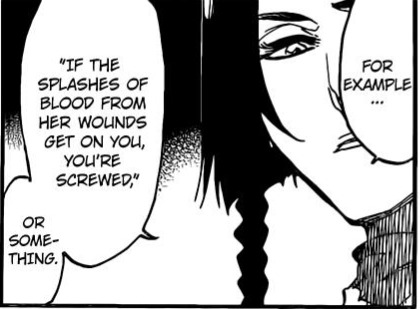
Sound familiar? It probably should. Because it’s very likely what Akoya would also be capable of.
With all that being said, there’s probably more I could say on these two’s hidden depths, but I can’t really think of them at the moment. So I’m just gonna leave these here:
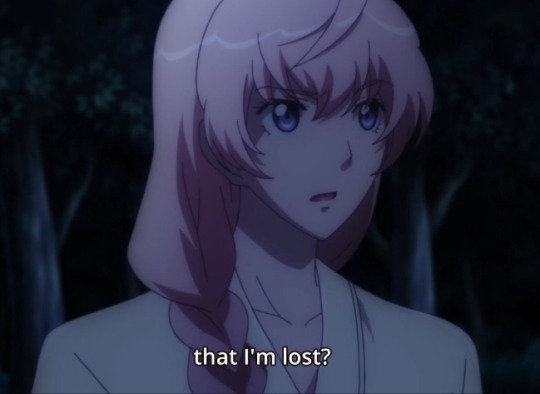
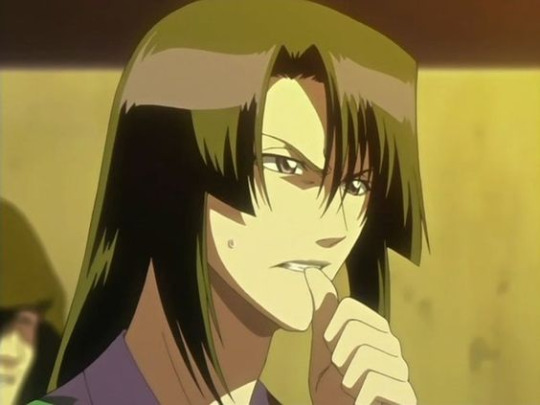
#first time writing this kind of analysis tbh#sorry if it's not in-depth or all that accurate!#lulas's randomness#lulas's meta stuff#yumichika ayasegawa#akoya gero#boueibu#bleach#this kinda assumes you know something about the series so I'#m sorry if this is a bit confusing ;; v ;;#there's probably more but this is all I can think of and it's a bit jumbled up#aaa @elucida I hope you don't mind me referencing your post/meta on akoya b tw
8 notes
·
View notes
Text
Samson and Sally
Welcome to the 'highglossfinish' room. Thenightetc: *is summoned by noises coming from the tab* Thenightetc: omg. Shockbox: ...Interesting way to start the night, Knock Out. Knock Out: The humanling deserved an audience. Thenightetc: That was extremely cute. Shockbox: Fair enough. Knock Out: I hope everybody's ready for an obscure film about whales dying horribly. Thenightetc: Is that what this is going to be? Thenightetc: I've never heard of it, so Ratchet: I'm actually glad Radar decided not to stay for stream night. Knock Out: It's...certainly something. Thenightetc: So it's like Watership Down but with whales? Knock Out: More or less.
Shockbox: I have not seen this film nor Watership Down. Shockbox: But it sounds like a ride. Thenightetc: Watership Down is *great*. Also harrowing, but great. Shockbox: What. Shockbox: That does not seem to be the variety of whale well known for eating anything larger than krill. Shockbox: Then again, I'm no marine biologist. Shockbox: Hm. Knock Out: There's a version in English, but it's fairly painful. Thenightetc: Biological accuracy doesn't tend to be a feature of these kinds of films Thenightetc: ...witness, the octopus with a mouth on the front Shockbox: That is /abhorrently/ inaccurate. Knock Out: And a penchant for grabbing young whales in dubious places. Ratchet: Well, that's morbid. Knock Out: Definitely for the best that Radar sat this one out. Shockbox: Is it lagging for anyone else? Thenightetc: Does it keep ... yes, for me too. Knock Out: Hold on. Let me fix that. Shockbox: Glad I wasn't suffering alone. Thenightetc: The problem seems to be with the livestream connection, not the movie itself. Knock Out: That should help. Thenightetc: yyyyyes, that's probably true. he's not dead, he's just... somewhere else. Thenightetc: (The lag seems to be fixed!) Knock Out: Excellent! Knock Out: Wouldn't want to miss out on this all riveting...whatever this is. Knock Out: *all this Shockbox: They appear to be torturing the polar bear? Shockbox: Or, well, they were. Thenightetc: Or stealing its food, at least Thenightetc: ...I like the killer whales' leitmotif, at least Knock Out: If there's one thing this movie has going for it, it's the music. Shockbox: ....Promotion only? Knock Out: It was legitimately the only copy I could find. Shockbox: Hm. Thenightetc: So are the killer whales sapient, too, or...? Ratchet: Human data stream's funny that way Thenightetc: ...How did they carry that up there Knock Out: I take it back. Watership Down this isn't. Thenightetc: Why do they have feet Thenightetc: what ARE they Shockbox: ....... Knock Out: I'll have whatever they're having. Thenightetc: This just raises further questions Shockbox: I suppose nothing in this film can bother to be anatomically accurate. Thenightetc: GAH Knock Out: This has gone on about three minutes longer than it needed to. Thenightetc: oh thank god. Thenightetc: Oh, they're alive. Never mind. Shockbox: I'm just. Shockbox: Tilting my head at the screen. Thenightetc: ...what Shockbox: I beleive that is what the humans refer to as a 'Big Lipped Alligator Moment'. Knock Out: Radiation poisoning explains a lot about this world. Shockbox: It really does. Knock Out: Watch out for Lavender Sweater McWhitePants there. Thenightetc: Does that bird have teeth? I think I saw teeth Knock Out: Radiation. Thenightetc: Why are they still hanging around in the same area Shockbox: The bird was flying so /slowly/, how did the man allow this to happen to himself. Thenightetc: *shudder* Knock Out: Can't they call him something else? Ratchet: ... I'm not terribly sure what I've come back to Thenightetc: Why do the makers of this movie hate octopi so much, who hurt them Shockbox: On the behalf of all cephalopods, I am mildly insulted. Shockbox: ....Those /slapping noises/. Shockbox: Primus. Knock Out: Did they just...? Thenightetc: This is like that bit in The Lion King Thenightetc: That sure is how ships work. Knock Out: This movie's just full of how everything works. Shockbox: Upon performing a quick search through the human internet, these appear to be sperm whales, which /do/, in fact, consume cephalopods. Shockbox: So this is accurate to a degree, but it doesn't excuse what they did to the poor octopi. Thenightetc: It does not. Ratchet: ... well Thenightetc: Or the... walruses? Whatever those were. Thenightetc: With the dancing. Shockbox: The only accurate thing in this film are the references to the sperm whale's dietary habits. Shockbox: And even then, I have only seen them consume octopus. Knock Out: They bid an emotional farewall to the "promotion only" sign. Shockbox: Yes, the text showing up at random intervals certainly adds to the experience. Thenightetc: ...what Knock Out: My personal favorite was when it showed up in the middle of the walrus song. It seemed...fitting. Knock Out: That moon, though. Knock Out: Is that normal? Shockbox: No. Shockbox: No it is not. Shockbox: That is just as bad as drawing stars on top of the shadow-cloaked portion of a given satellite. Ratchet: ... is... what is happening at this point? Thenightetc: It's showing us about the evils of pollution. Shockbox: ...I have to agree with your comment earlier, KnockOut. The background music can be pleasing. Knock Out: Wait 'til you hear the background music they pull out at the end. Knock Out: Makes all the rest worth enduring. Knock Out: ...And apparently, this is the first time he's seen the sun set over the ocean? Thenightetc: Maybe? Thenightetc: Did that turtle just Shockbox: She needs to stop doing that. Shockbox: That is physically impossible. Shockbox: Not that such mistakes are surprising, given this film. Shockbox: /Perfect timing for this text./ Knock Out: His corpse sounds like an old tarp. Knock Out: ... Shockbox: Hm. Thenightetc: well then. Thenightetc: Why is he such a blob Thenightetc: I love how there are all these modern-ish buildings in this ancient mythical city. Knock Out: Ooh, here it is. Thenightetc: Also cars. Knock Out: This slow jam. Thenightetc: ...Oh. Ratchet: I wouldn't call it an "ancient mythical city," considering that particular landmark. Thenightetc: Yeah, okay, it's just they kept calling it Atlantis. Ratchet: Did they? I couldn't tell. Thenightetc: Or they did at the beginning. Knock Out: Right on schedule. Ratchet: Is there a particular reason that every "mankind is destroying themselves" film uses that particular statue as an indicator that humanity has failed its planet? Thenightetc: It's recognizable, it's American, and it's near the coast? Ratchet: It's certainly two of those things. Knock Out: And that's the end of that little experience. Shockbox: Well. Shockbox: That was anticlimatic. Thenightetc: All that just happened. Shockbox: Indeed it did. Knock Out: It did. It really, really did. Knock Out: If anyone else has anything they'd like to see to end on a more climactic note, feel free to throw out suggestions. Shockbox: Hmm. Thenightetc: https://www.youtube.com/watch?v=Uk6Ejm6mN1w ? Thenightetc: "Hermione the octopus eats a crab- close up " Ratchet: If it wasn't a full-length film, I would suggest... primus, whatever that movie is that she keeps talking about. Shockbox: I approve of us ending this with cephalopods. Shockbox: They deserve more appreciation. Thenightetc: They're great. Shockbox: 'To sleep'. Knock Out: Humans do love lying to children. Thenightetc: Why not? Shockbox: .....What is this video called? I want to save it. Knock Out: "Homosexuality in Octopuses." Shockbox: My thanks. Shockbox: I need to capture some of these creatures upon my next visit to Earth. Knock Out: And to wrap it up, these same scientists laughing at a cuttlefish. Thenightetc: Oh my gosh Thenightetc: ...it's not mov oh, there it goes Ratchet: What Thenightetc: What's that lower left one Thenightetc: With the... mouth Shockbox: Now /this/ is the climax we all had been anticipating. Shockbox: I do not regret joining this stream. Thenightetc: ...Is the octopus trying to eat the toy Thenightetc: *concerned* Shockbox: They tend to nibble on things curiously. Knock Out: Like most newsparks. Ratchet: Like a surprising number of newsparks. Knock Out: There it is! Rainbowmouth. Thenightetc: *leans forward* Shockbox: Intriguing... Knock Out: This human annoys me, but this is interesting. Thenightetc: Huh. Thenightetc: What are those *teeth* Shockbox: Ah, I'm familiar with these. Knock Out: It looks like it hurts to be it. Thenightetc: Woah. Shockbox: /Leaning forward. Shockbox: ....I will need to collect more than just cephalopods, upon my next visit. Knock Out: Collect this human too, if you don't mind. Dissolve him in something. Thenightetc: *...leans back* Shockbox: Hm, I /did/ run out of human samples... Knock Out: This one, then we'll call it a night. Shockbox: I am fine with this. Knock Out: This human has a more pleasant voice. Ratchet: https://www.youtube.com/watch?v=IyYo3Hm6pS4 Ratchet: Rafael sent this about fifteen minutes ago and for some reason I cannot stop laughing. Thenightetc: ...it kind of looks like a shaved bear. Knock Out: You know what's nice? How humans are stuck on this world, but I'm not. Shockbox: Hm. Shockbox: Thank you for the stream, Knockout. Knock Out: My pleasure. Thank you for stopping by! Thenightetc: Yes, thank you! Knock Out: Good night, everyone! Shockbox: Another time. Thenightetc: This was great... some parts moreso than others.
0 notes